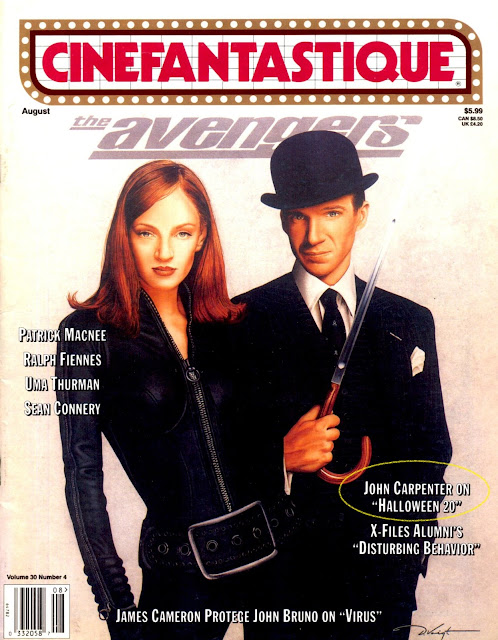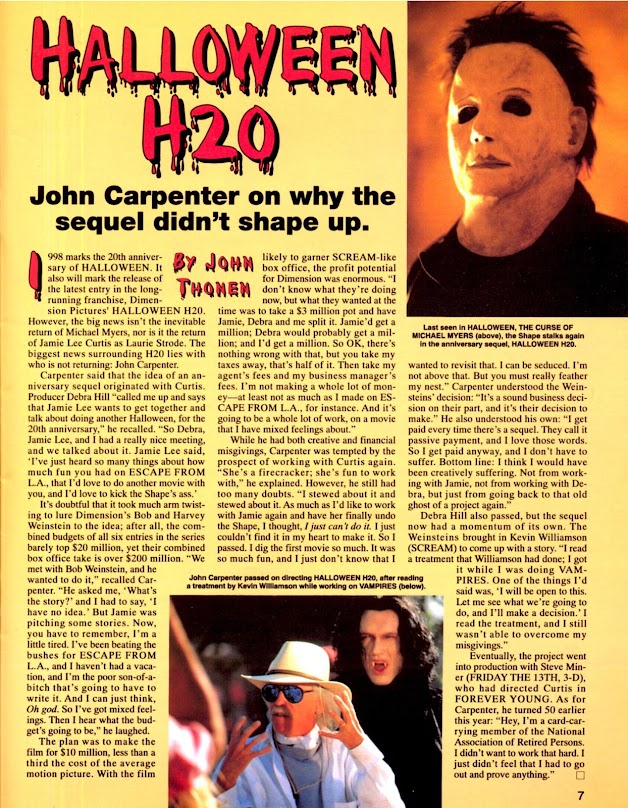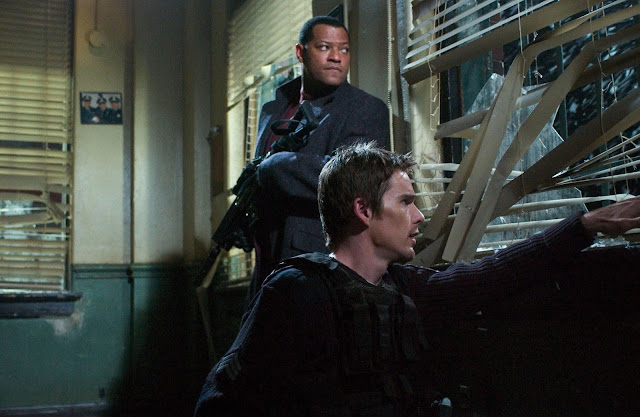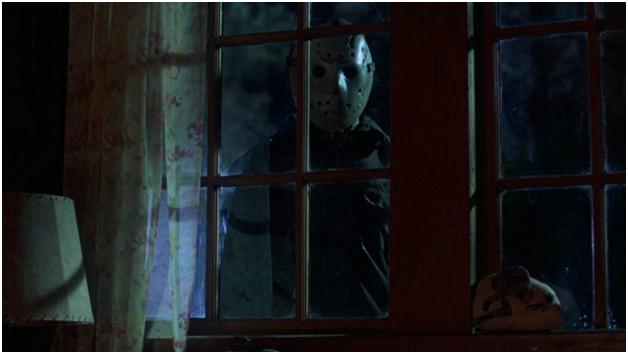I wrote this archival piece nearly two years ago, and nearly one year before Halloween (2018) was released upon the world (exactly one year ago today, in fact). More than just a musing on what I thought David Gordon Green might add to the franchise, it was a reflection on growing up alongside the Halloween franchise, how it forged my love for the genre, and how absurdly, ridiculously excited I was, at fourteen years old, for Halloween: H20 (1998) -- the first Halloween sequel to seize on a 20-year anniversary, and to bring Jamie Lee Curtis back to the franchise. At this point, production on the next entry in the franchise, Halloween Kills, which returns all the major participants from Halloween (2018) for another go-round with the Shape, is well underway. While we all anticipate this next sequel, let's go back in time a little for a melancholy dose of watching both Michael Myers as well as the calendar...

As a kid, I was a devout Michael Myers fan. Granted, I was a horror
junkie in general, but there was something about that white-masked boogeyman
that fueled my imagination and struck fear into my bones like lightning. I can
still remember my elementary-school self waiting impatiently in the living
room, on Halloween, for my older brother and his friend to complete their dead
hockey player costumes by gluing half-pucks to their faces. It took so long,
and I was so antsy to get out there and trick-or-treat, that I flipped on the
television hoping to find distraction in the cadre of Halloween-appropriate
titles sure to be on. While surfing, a burst of screams and frantic chaos in
the dark caught my attention. Feeling good about my choice, I’d put down the
remote and began to watch.
That was how I first discovered John Carpenter’s Halloween.
Okay, fine, it was only the last ten minutes or so, but as a young
horror-loving fiend, what better time to tune in? The film was at its frenzied
peak, and the suddenness and ambiguity of the terror helped to heighten the
experience. Who was this man in the mask? Who was this old man in the trench
coat trying to stop him? Why here, why now? What is this?
I saw it all — Laurie Strode fleeing and shrieking across the street from
masked maniac Michael Myers; her frantic pounding against the locked front
door; the couch attack, the closet attack, and the final confrontation where
Michael was unmasked and Dr. Sam Loomis shot him directly in the jumpsuit.
For a moment, everything was quiet. The shot had knocked Michael
offscreen into a back room. Surely he was dead, right?
Loomis ran into that same back room after him. Michael waited in the
darkness — still, and very much alive.
At that moment, seeing his unnatural stillness framed by darkness, I
was petrified. Beyond petrified. I
couldn’t move — something so simple as a scary mask in silhouette, with a bit
of inhuman breathing, and I couldn’t fucking move.
Five more gunshots rang out. Michael flew backwards off the balcony
and landed with a crash on the cold hard October ground. Finally, he appeared
dead.
But after a quick cut away, his body was gone.
And thus began a forty-year legacy.
After that fateful television viewing of
Halloween, I was hooked. One by one I sought every remaining
sequel, skipping
Halloween 3: Season of the Witch, as I’d go on to learn that it didn’t feature the babysitter
murderer known as The Shape. (I’d eventually mature and warm to this entry,
which I now watch every Halloween.) This love for the series continued for
years. I bought every
Halloween
available on VHS, including multiple copies of the original. I bought every
magazine or book or figure or poster or anything that bared the face of Michael
Myers. Had there been a
Halloween
secret society, I’d’ve been a charter member.
1995 rolled around and I was in the fifth grade. One Friday in
September, a childhood chum named Barry and I were swapping weekend plans on
the bus ride home.
“My sister’s taking me to see Halloween
6 tonight,” Barry said casually.
My face went full :O and I
begged him to take me along.
He did, and soon after, he became a boyhood best friend.
Flash forward a few years. It’s 1998, and I’m in eighth grade. My love
for horror continues, and sometimes I’m successful in forcing my friends to go
along with it. Scream 2 had proved
such a massive box office success that Dimension Films re-released the sequel
for encore showings. And so of course I went. It was then, in the
popcorn-smelling dimness of the auditorium, that one particular trailer stuck
out among all others:
From the audience’s point of view, we glided down long hallways as
heavy winds made curtains billow and dry autumn leaves dance across the floor.
An ominous voice growled, “he has pursued her relentlessly…”
Meanwhile, the tick-tock piano music in the background sounded so familiar…
“He has hunted her…everywhere…”
I knew I’d heard that music
somewhere…
“Twenty years later, the face of
good and the face of evil will meet…one last time.”
The music was a track called “Laurie’s Theme” from the Halloween soundtrack, and the trailer,
which suddenly flashed to Jamie Lee Curtis looking through a window directly
into the darkened eyeholes of Michael Myers, would end with the Halloween theme and the title Halloween H20: Twenty Years Later
shrieking across the screen.
What I felt at that moment was indescribable — an insane amount of
shock and surprise and excitement that I still haven’t felt for a movie to this
day. It was euphoria. It was like meeting a superhero, or winning the lottery.
A franchise that had seemed all but dead after the abysmal Curse of Michael Myers was suddenly back with a vengeance, and not
only that, it was also hailing the return of Laurie Fucking Strode, the ultimate
final girl.
In the dark, I could feel my friends look over at me and make their
own :O faces. They didn’t care
nearly as much for horror and the Halloween
franchise as I did, but I could feel their excitement for me. And they were
right. At that moment, I didn’t care about anything else. Once I regained my
composure, I excitedly ran out of the auditorium and to the nearest payphone.
(Yes, a payphone — it was 1998, ok? The only people with cell phones at that
time were Mulder and Scully.) There was one person who needed to know – Barry,
my horror movie/Halloween partner in
crime – and he needed to know NOW. I was overjoyed, over the moon, and not
thinking clearly. I felt like a celebrity, as if I had been the first person in
the world to experience such groundbreaking news, and it was my privilege and
duty to alert the masses.
Seeing that trailer was magical. To be taken completely by surprise
still lives on in my mind as one of the happiest moments I’ve ever experienced.
And here I am, nearly 20 years later, and the idea behind what I am saying –
undying devotion for what is essentially Halloween
7 – sounds completely ludicrous. But that’s the kind of magic I suspect
dies off as your childhood does.
By the time I got back to the auditorium, Jada Pinkett was already
dead. I was so excited by this revelation that the exploits of Ghostface and
the stabbing of Sarah Michelle Gellar barely registered in my mind. Suddenly, Scream 2 didn’t mean shit in the face
of Halloween: H20.
For months after that, I waited impatiently for the poster to appear
in the theater’s lobby — to confirm that it wasn’t all just a dream, but a
reality. And once it arrived, I stared at that poster and marveled at The
Shape’s mask, and took in the pure pleasure of knowing it was coming soon…
Consumer-grade internet had just become a thing (we’re talking AOL
3.0), so naturally, for the next several months until Halloween: H20’s
release, I would Ask Jeeves and AOL Netfind everything I could about this new
sequel. I’d click over and over on distributor Dimension Films’ official
website and watch the trailers and look at the photos. Every fold of my brain
needed to be saturated with every bit of info I could find. Though I’m now of
the age where I depend significantly on an internet lifestyle, I can also
remember what life was like before it. Back then, if you wanted to know about
the next installments of Phantasm or
Halloween, you only had Fangoria Magazine. And all you were
allowed to know about their productions was what Fangoria allowed you to know – a quote here, description of a scene
there, and topped off with a publicity still that, nine times out of ten,
wasn’t indicative of the final film. Back then, I wasn’t in the habit of
bookmarking film sites and receiving daily news updates about projects in
production. Nowadays, as a grumpy adult with the internet on his phone, I can
assure you that finding out about a new Halloween
sequel coming soon in the form of an article by an online pipsqueak movie
writer isn’t nearly as magical as seeing that same sequel’s trailer in a
theater for the first time — the very first sign to you that it existed.
Always the pioneer, I began assembling my own version of Halloween: H20 “special features” on a VHS tape based on material recorded off
television; it included a Sci-Fi Channel hour-long making-of special; an MTV
thing where the cast and story writer, Kevin Williamson, hosted Dawson’s Creek trivia in between music
videos; and multiple appearances of the cast on late-night talk shows. I
watched that tape over and over until I could finally see the film for myself.
Opening weekend, I finally did — myself and a whole host of my chums
I’d likely strong-armed into going. My eighth-grade self was not disappointed.
Seeing Jamie Lee Curtis holding an ax and furiously bellowing her brother’s
name gave me chills. By film’s end, I was legitimately shocked and a little
heartbroken to see Michael lose his head. I was very happy with it, and my
chums seemed to have enjoyed themselves as well. After months of foreplay, the
big moment had arrived: the rolling out of
Halloween:
H20 felt like the successful culmination
of a plan I had nothing to fucking to do with, yet I couldn’t have been more
pleased with myself. At home I put together a framed Michael Myers memorial,
complete with birthdate and death date, because I was a silly nerd/psychopath.
Too young to understand the concept of commerce over creativity, I felt assured
Halloween:
H20 would be Michael Myers’ final hurrah (LOL), and while that made
me sad, I felt that it was a perfect finale. (As an “adult,” I look at
Halloween:
H20 with a more critical eye, as its shortcomings are no longer
veiled by childhood romanticism. The mask, which changes frequently, even
relying on CGI for one scene, is terrible; the California shooting location lacks
that small-town and autumn feel of Haddonfield, Illinois; the stuntman who
donned Michael’s mask and jumpsuit was just a hair too pint-sized to be fully
intimidating; and except for the lush and orchestral rendition of the
Halloween
theme, John Ottman’s score, Frankensteined with Marco Beltrami cues from
Scream and
Mimc, is all wrong. Those misgivings aside, I still think
it’s the best Myers-centric sequel since
Halloween 4: The Return of Michael Myers.)
What might be the longest intro in the world leads us to the point of
all this.
I was born in 1984. By then, the original Halloween was six years old, though I wouldn’t know it existed
until the mid-’90s. That’s ten years. When you’re a kid, ten years is forever. Halloween: H20 was the twentieth anniversary of the original film, but to me
it was basically Halloween: H4VR. Anything that predated my
existence didn’t jive with the timeline of my life. I couldn’t appreciate the
full sense of that anniversary because I didn’t exist or wasn’t cognizant for
most of it.
Halloween: H20 may as well have been the
bicentennial.
Here were are, in 2017, just a couple weeks away from 2018. And with
it comes the twentieth anniversary of
Halloween:
H20, and the fortieth(!) anniversary
of the original. A new
Halloween film
is in production — for the intent of my point, let’s call it
Halloween:
H40. Like
Halloween:
H20, this new film will be ignoring all
the sequels and getting back to the original’s roots of dread, suspense, and
little emphasis on violence. And Jamie Lee Curtis returns as the embattled
Laurie Strode.

If you can avoid getting caught in the petty trappings of the
internet,
Halloween: H40 has a lot
going for it. The production is in good hands with Jason Blum,
who has kick started the horror genre over the last decade by sacrificing
multi-million dollar budgets in exchange for handing off full creative control
to the films’ talented writers and directors (a refreshing change of pace from
former rights-holding and extremely meddlesome Dimension Films/the Weinstein
brothers), with this approach resulting in new classics
Insidious,
Sinister, and
more. (Dude might also be nominated for an Oscar for producing
Get Out — you read it here first.) Jamie Lee Curtis is returning, of
course, but the casting of Judy Greer as her daughter shows that the production
is more interested in talent than vapid Facebook-level recognition value. John
Carpenter returns to compose and consult. And it’s being directed by David
Gordon Green — an actual filmmaker — who, comedies aside, has a solid body of
work, including the very underrated,
Night
Of The Hunter-ish stalker thriller
Undertow.
As of this writing, not a single frame of Halloween: H40 has been
shot, but it’s already as terrifying to me as the original was all those
Halloween nights ago. Because, to me, Halloween:
H20 is only a few years old. I
remember everything about the excitement I felt in the months leading up to its
release. I remember going to see it, that all my boyhood chums came with me,
and what each and every one of them said about it after the credits rolled. I
even remember, upon Michael’s first on-screen appearance, my friend Kevin
jokingly whispering to me, “It’s him, the guy from the ad!,” quoting from an
episode of The Simpsons — something
we did constantly.
Within the confines and timeline of my life, Halloween: H20 feels
like it just happened to me. There’s no possible way it’s been twenty years.
Yes, I’ve lost friends and family; I’ve moved multiple times; I’ve gotten
numerous jobs; I’ve been lucky enough to have fallen in love a couple times.
Those childhood friends who went with me to share in my excitement of
Laurie Strode’s return, all of whom I miss dearly, eventually scattered to
different parts of the world, and it’s been years since I’ve spoken to any of
them. All of that makes a solid case for a two-decade timeline. But there’s
just no way. I can’t fathom it. And I don’t want to.
As a film fan, a horror fan, and a Halloween fan who has weathered some serious mediocrity over the
years, I’m more excited than anyone for the coming of Halloween: H40.
But as a mere mortal keeping a wary eye on the clock and the calendar,
it just might be one of the most terrifying films I ever see.
[Reprinted from Daily Grindhouse.]

















































